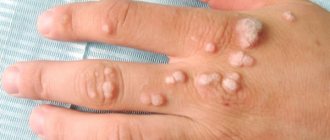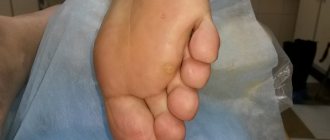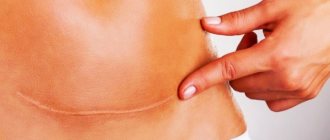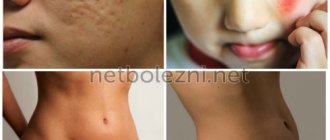Surgical intervention involving skin incisions does not pass without leaving a trace. Scars remain on the surface of the body. Some of them are small and unnoticeable, while others are large, bright, protruding above the surface of the skin.
It is completely impossible to remove scars after surgery, but it is quite possible to make them miniature and light. Modern cosmetology procedures will help with this.
Classification of postoperative sutures
How quickly the sutures heal after surgery largely depends on the nature of their application and the materials used. In this regard, post-surgical procedures are usually classified as follows.
- Bloodless (the edges of the wound are glued together with a special plaster) and bloody (a classic suture that is applied manually with a medical instrument). In turn, the latter are divided into:
- simple knots (applied at a distance of 1–2 cm from each other, after which the knot is tightened until the edges of the incision touch);
- intradermal continuous (considered the most effective, since after their healing there are no traces left);
- mattress (applied after abdominal surgery);
- purse string (used in plastic surgery, as well as in operations to reduce the volume of the stomach);
- entwining (circular sutures that are used to sew together blood vessels and hollow organs).
- Manual (applied with a needle, thread and other special tools) and mechanical (performed with a medical stapler).
- Submersible (applied during operations on internal organs with threads that are absorbable or implanted into living tissue) and removable (they are used to stitch the skin, and after the edges of the wound have fused, the threads are removed).
Absorbable sutures are made in cases where long-term fixation of the edges of the incision is required, for example, when cutting the uterus during a cesarean section. As a rule, they are performed with threads from purified connective tissue, which is subsequently rejected into the organ cavity. To apply removable sutures, threads and other fasteners made of cotton, silk, metal and other non-absorbable materials are used (more than 30 varieties in total).
Hand stitching tools
Types of scars
The size, location and visibility of postoperative marks depend on the type of abdominoplasty.
- The classic operation leaves a long incision, located in a horizontal direction and passing through the entire abdominal area. In some cases, small incisions in the shape of a horseshoe or triangle are possible, particularly if repositioning of the navel is required.
- Vertical abdominoplasty is most often indicated in the presence of diastasis of the abdominal muscles. This technique combines a classic plastic surgery incision and a vertical one, running from the navel to the sternum.
- To remove fatty tissue located on the sides and form a pronounced waist, you will need a classic incision and two side incisions located in parallel.
- If it is necessary to perform a lift in the hip area, then a horizontal incision is combined with two lateral ones extending to the lower back.
- Mini abdominoplasty involves the removal of a small amount of tissue, so in this case the mark after the operation is short in length (no more than 20 cm), located along the bikini line and is usually hidden under underwear or a natural fold of the body.
- Circular abdominoplasty is considered the most complex technique; with this technique, incisions are made in the abdomen, around the body, on the sides and on the back.
How to care for the suture after surgery?
Once the edges of the incision tighten, there will be no need for additional support. Removal of sutures in the head, face and neck area occurs already on the 5th day after the operation. If they were applied in the area of the torso or limbs, then it will take at least 10 days for the wound to heal. Daily dressings are necessary for the first few days. The patient usually spends this time in the hospital. After discharge, tight bandages are usually no longer needed. But if necessary, you can always change the dressing at the nearest hospital or medical center.
Caring for the suture after surgery consists of daily treating the incision area with an antiseptic and taking medications that accelerate tissue regeneration. All medications for home therapy are used strictly according to the doctor’s recommendation!
Treatment of sutures is usually carried out with ready-made pharmaceutical preparations or homemade antiseptics, such as solutions of iodine, potassium permanganate, brilliant green or hydrogen peroxide. To avoid getting a chemical burn when performing such procedures, the liquid for disinfection should be prepared only according to a prescription issued by a doctor.
To speed up regeneration processes, external agents with wound healing and antibacterial effects are used. These include balsamic liniment (better known as Vishnevsky ointment), levomekol, ichthyol ointment and many others.
Pain of varying intensity after surgery is absolutely normal. If discomfort is severe, analgesics approved by your physician may be used.
Swelling and bruising after blepharoplasty
After almost any operation, swelling and bruising occur in the area of surgical trauma due to the intersection of blood and lymphatic vessels. All patients are concerned about the question of when the swelling and bruising will go away after blepharoplasty, how long they last and how to remove them. As can be seen from the rehabilitation calendar, during the first 3 days the swelling increases and then begins to gradually subside. By 2-3 weeks, most patients already have a presentable appearance. The swelling completely subsides by 6 months. A number of remedies can help remove dark circles under the eyes and swelling:
Lyoton
Gel for external use.
Direct anticoagulant for external use, which has a local antithrombotic, antiexudative, moderate anti-inflammatory effect, accelerates the processes of resorption of hematomas and blood clots and reduces tissue swelling.
traumeel
Ointment for external use. A multicomponent homeopathic medicine, the effect of which is determined by the components included in its composition.
troxevasin
Troxevasin® is a flavonoid (rutin derivative). Has P-vitamin activity; has venotonic, venoprotective, decongestant, anti-inflammatory, anticoagulant and antioxidant effects. Reduces the permeability and fragility of capillaries, increases their tone.
Additional recommendations for suture care after surgery
In addition to medical procedures, certain lifestyle adjustments are also necessary in the postoperative period. In particular, the following rules must be adhered to:
- Limit physical activity. Any high and medium intensity exercise (running, aerobics, etc.) during this period is strictly contraindicated.
- Avoid heavy lifting. As a rule, a person who has undergone surgery should not lift more than 2–2.5 kg. This rule is especially relevant when caring for a suture on the abdomen after surgery.
- Limit mobility in the waist area (avoid sharp and high-amplitude bends and turns of the body) after abdominal surgery.
- Carry out water procedures with great care. Before the stitches are removed, or better yet, before a scar forms, it is strongly recommended not to wet the wound.
- Avoid any pressure on the wound. When it comes to how to care for a suture after surgery, this is one of the main rules.
- In cases where surgery was performed on an arm or leg, the injured limb should be placed above the level of the heart (for example, placed on a pillow) during sleep. If the wound is above the level of the neck, then it is better to sleep with the head of the bed raised by 45° (two pillows are enough for this).
- During abdominal operations, observe bed rest until the doctor allows you to break it. To avoid bedsores and improve blood circulation, you can perform simple movements such as lifting your limbs and performing light self-massage.
- Strictly follow the diet prescribed by your doctor (especially after abdominal surgery).
- Protect the wound from exposure to direct sunlight. After the tissue has healed and until a full-fledged skin forms in this area, you can use sunscreen.
Scars (scars) after blepharoplasty of the upper and lower eyelids
Many patients have a question: do scars remain after surgery? Of course they remain. But you shouldn’t be scared, since they are practically invisible and look like a thin strip, and with transconjunctival blepharoplasty they are not there at all.
The next reasonable question is how to remove scars?
It is impossible to completely remove scars; you can make them almost invisible. And for this, after the operation it is necessary to undergo special treatment. And then patient reviews on the quality of scars after blepharoplasty will be 99.9% positive.
photo scars / scars after upper/lower blepharoplasty
And one more question that concerns patients: what should they use to smear the scars after surgery so that they are invisible? Let’s look at these remedies and scar treatment in more detail.
Scar treatment
There are a huge number of different scar care products, including various drugs:
Gel after blepharoplasty
contractubex
It is a combined preparation in the form of a gel, the effect of which is determined by the properties of its constituent components: Allantoin, Heparin sodium, Onion. It has fibrinolytic, anti-inflammatory (due to the extract of Serae bulbs), antithrombotic (due to heparin), and keratolytic effects (due to allantoin). Causes stimulation of cellular regeneration without hyperplasia. Prevents the formation of keloid scars by inhibiting fibroblasts.
dermatix
The drug is in the form of a silicone gel for external use, transparent, colorless and odorless. Consists of a mixture of polymeric organosilicon compounds (polysiloxanes). Helps maintain uniform moisture in the eyelid skin, has a corrective effect on scars after upper and lower blepharoplasty, smoothing and softening them, relieves pain, itching and discomfort, and also reduces skin redness.
Silicone patch
Silicone patches are also a large group of scar care products. But when applied to eyelids, they are not entirely comfortable. The most famous companies on the Russian market are Dermatix and Mepiform.
Enzyme preparations
A group of drugs intended for the treatment of hypertrophic and keloid scars.
longidase
Longidase is a drug whose main active ingredient is the enzyme hyaluronidase. This enzyme
- increases the permeability of connective tissue;
- stops the process of gross scarring by reducing the formation of its own collagen in the cells of the dermis;
- increases the level of elasticity of the skin of the eyelids.
The drug is available in the form of a dry substance in ampoules. Before use, it is dissolved in 2 ml of liquid (saline or 0.25% lidocaine solution) and injected directly into the scar with a needle.
lidase
An enzyme preparation whose main active ingredient is hyaluronidase.
It is known that hypertrophic and keloid scars are formed due to excessive synthesis of hyaluronic acid. With its participation, at an early stage of the wound process, the production of fibroblasts is stimulated, which produce new skin cells in huge quantities.
When lidase is introduced, excess hyaluronic acid is eliminated, since lidase acts on this acid and decomposes it into glucosamine and glucuronic acid. As a result, microcirculation and cell permeability improve in the scar area.
Available in ampoules as a lyophilisate. Before use, like longidase, it is dissolved in saline and injected under the problematic scar. If injections of the drug are painful, it is better to dissolve it in a lidocaine solution.
imoferase
Eye cream after blepharoplasty, like Lidaza, contains the active ingredient Hyaluronidase, which suppresses the growth of connective tissue and reduces swelling.
With a course of treatment, raised scars decrease in volume, pigmentation decreases, and the elasticity of the eyelid skin increases.
A good property of Imoferase Cream is its ability to act on old scars and scars, reducing their density.
Hormonal ointments and suspensions
hydrocortisone
Hydrocortisone ointment has an anti-inflammatory effect and inhibits the growth of connective tissue. It is used after blepharoplasty and eyelid pathology. Hydrocortisone is a glucocorticosteroid, the use of which can cause many side effects. Therefore, the drug can be used only when prescribed by a doctor.
diprospan
The main active substance is the glucocorticosteroid betamethasone, the effect of which is that it stops the pathological growth of scar tissue, causing the scar to become smaller and flatter. The main indication for use is keloid scars. Uncontrolled use can cause tissue atrophy.
After blepharoplasty it is practically not used
Limitations after blepharoplasty
After blepharoplasty, it is necessary to follow the recommendations for a restrictive regime. Below are the dos and don'ts after surgery:
sports and physical activity
During consultations, I always tell you in detail when you can start playing sports after blepharoplasty. In the first days, it is better to avoid any exercise, as this can lead to an increase in blood pressure and provoke bleeding. A home regimen for 2-3 days is recommended. As a rule, after a month you can fully start playing sports and fitness.
solarium
You can visit the solarium 1 month after blepharoplasty, but be sure to cover the eyelid area, otherwise persistent hyperpigmentation may appear.
alcohol and smoking
Many patients are concerned about when they can drink alcohol and smoke cigarettes after blepharoplasty. It’s better not to drink or smoke at all and say “no” to bad habits! But if you really want to, then no earlier than 2 weeks, as they negatively affect healing.
Tan
You can sunbathe in the sun after 1 month, but you need to use sunscreen, otherwise you can get persistent hyperpigmentation
makeup
Many people are interested in when they can paint their eyes after blepharoplasty. Makeup (cosmetics) can be applied within 5-7 days after surgery. It is necessary to pay attention to any redness, and if it appears, you need to remove makeup so as not to provoke an allergic reaction.
Job
You can return to work 3-5 days after blepharoplasty. But if possible, it is optimal to stay at home for 2 weeks.
eyelashes and tattoo
You can get eyelash extensions 1 month after eyelid surgery. Tattooing can be done 1 month after surgery.
lenses and vision
Lenses after upper blepharoplasty can be put on immediately, and after transconjunctival blepharoplasty - after 10-14 days. For a period of up to 2 weeks, it is necessary to exclude working on the computer and phone, reading books, watching TV and giving your eyes rest.
Botox and Dysport
Botox or Dysport can be injected 1 month after blepharoplasty.
sex
There are no strict restrictions on sex
In what cases should you consult a doctor?
Seeking help from a doctor during the healing process of a suture is a completely normal practice, even in the absence of serious problems. And in the event of adverse reactions due to a violation of the treatment regimen or any unforeseen circumstances, it is absolutely impossible to delay it. First of all, it is dangerous to ignore the following symptoms:
- bleeding that cannot be stopped by conventional means;
- high temperature (more than 38 degrees);
- weakness, chills;
- increasing pain or other progressive discomfort that cannot be relieved with medications;
- purulent discharge of a bright yellow or green color with a thick consistency and very often with an unpleasant odor;
- severe redness, swelling, or swelling in the wound area;
- the skin at the site of injury is hard and hot to the touch;
- the appearance of a rash or blisters;
- Suspicion of seam dehiscence.
When should you not deal with scars at home?
Before starting any treatment, including getting rid of scars, you should consult your doctor. It will help you determine the most effective way to fight in your case.
It is definitely not recommended to use traumatic or unreliable products at home.
Treatment at home should be completely abandoned if in the area of the scar
- redness, irritation, and swelling of the skin are noted
- eczema, herpes or other skin diseases were discovered
- vessels appeared, the color of the defect changed dramatically
How long does it take for a wound to heal after surgery?
The rate of healing of a postoperative wound depends on many conditions. Among them:
- age;
- body mass;
- state of immunity;
- state of the cardiovascular system.
On average, it takes about 3 months from the moment of surgery to the formation of a scar. Depending on the complexity of the operation and if there are complications, this period may last 12 months. Tissue regeneration takes place in 4 stages.
- Inflammation (5–7 days). The body's standard defense reaction to damage. During this period, there is an increased production of substances that stimulate blood clotting.
- Polyferation (from 10 days to 1 month). At this stage, the formation of young connective (granulation) tissue, penetrated by a dense network of microvessels, occurs. At first it is bright red in color and grainy in consistency, but as the wound heals it becomes pale and smooth, and its bleeding decreases.
- Epithelization (from 1 to 3 months). The connective tissue is finally formed. Skin begins to form at the site of the wound. The number of vessels decreases, a scar forms.
- Scar formation (from 3 to 12 months). Temporary vessels completely disappear. Fibers of collagen and elastin - elements of connective tissue - form the scar.
How to care for a wound when the stitches are removed after surgery?
It would be useful to remind you that stitches should only be removed by a specialist - a doctor or nurse. It is strictly forbidden to perform this procedure yourself, due to the high risk of causing infection in the wound or causing bleeding.
Treatment of the incision site after removal of the sutures is carried out using the same means as before. Treatment procedures last until the wound is completely healed. This usually takes about 1 week.
Professional care for postoperative sutures at Stoletnik MC
If in any matters related to taking care of your own health, you prefer to trust professionals, you are welcome at the medical office. To help those who are not sure how to properly care for a suture after surgery, a wide range of post-operative services is available. Among them:
- dressing large and small;
- removal of stitches up to 5 cm;
- removal of sutures 5–10 cm;
- removal of stitches more than 10 cm;
- sanitation of the wound surface;
- scar excision;
- and much more.
The responsibility and high professionalism of the clinic’s staff is the key to the safe and speedy recovery of our patients. And the affordability of the services provided will eliminate the need to waste time and nerves on trips to the clinic. Sign up for procedures by phone: +7 (8412) 999-395, 76-44-20. We are waiting for you at the address: Penza, st. Chaadaeva, 95 (Shuist microdistrict).
Literature
- Belyaev A.N., Kozlov S.A., Taratykov I.B., Novikov E.I. Patient care in a surgical clinic: textbook. allowance. – Saransk: Mordovian University Publishing House, 2003. – 136 p.
- Buyanov V. M. Egiev V. N. Udotov O. A. Surgical suture. – M.: Antis, 2000. – 92 p.
- Zoltan J. Operating technique and conditions for optimal wound healing. – Budapest: Publishing House of the Academy of Sciences of Hungary, 1983. – 175 p.
- Mironova E. N. Fundamentals of physical rehabilitation. – M.: MOO “Academy of Safety and Survival”, 2016 – 310 p.
- Semenov G.M., Petrishin V.L., Kovshova M.V. Surgical suture - St. Petersburg: Peter, 2001. - 256 p.
Author: Korolev E. S.
Reviewer: reflexologist Kurus A. N.








